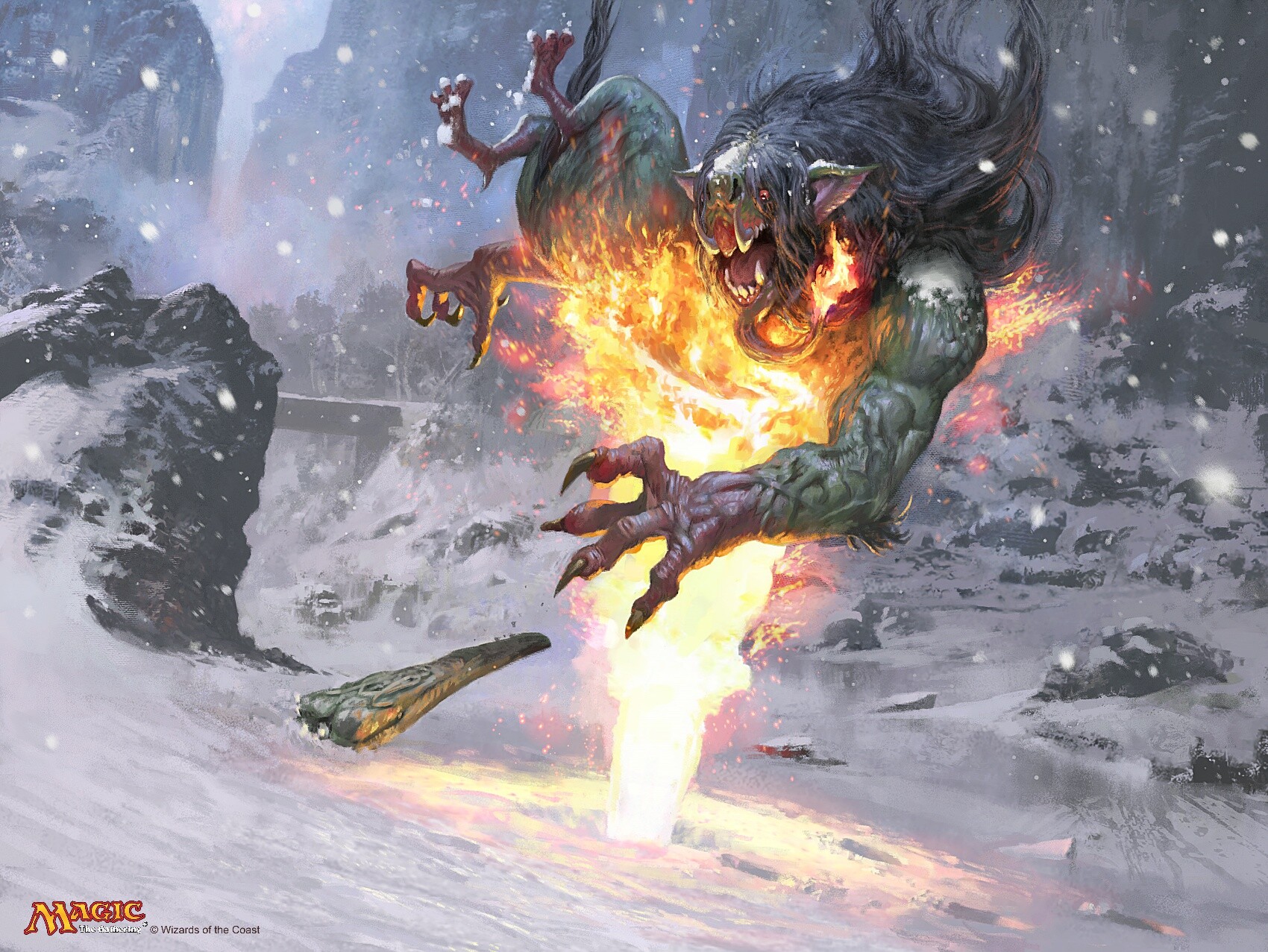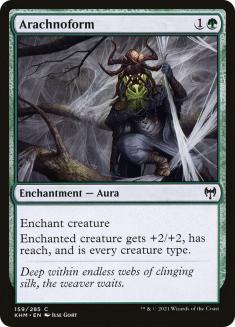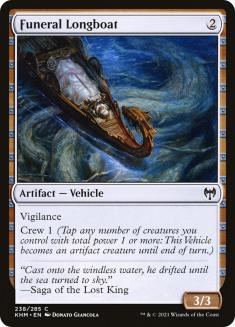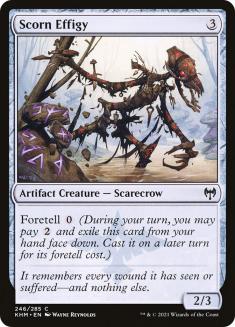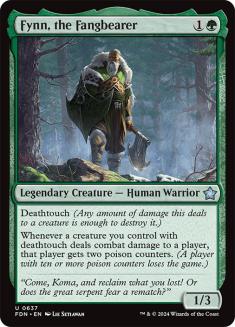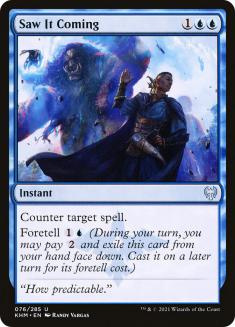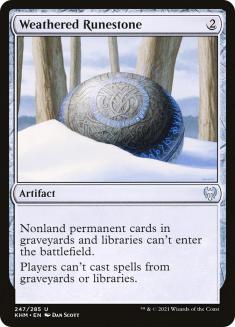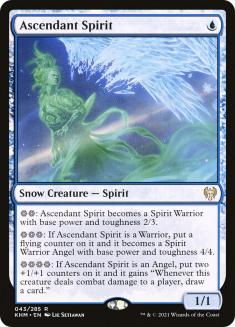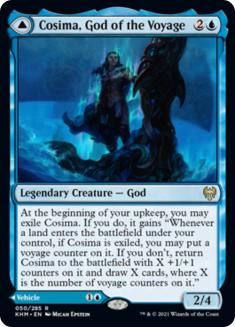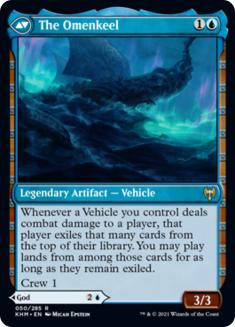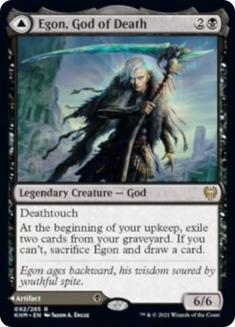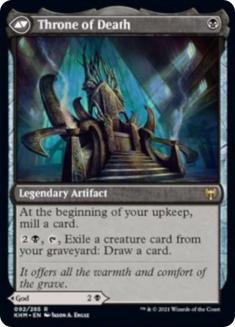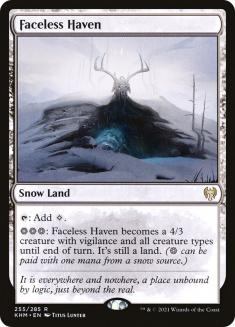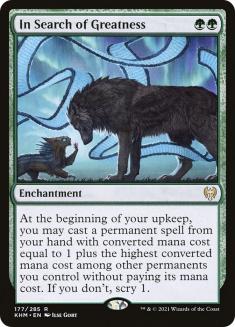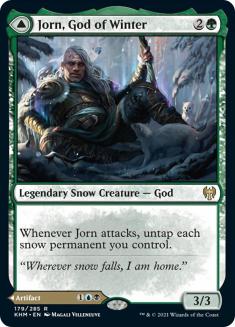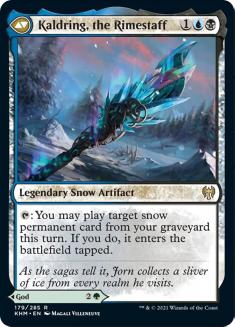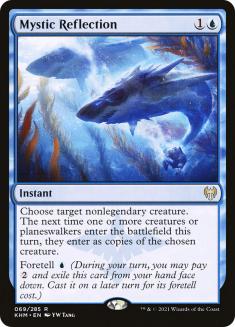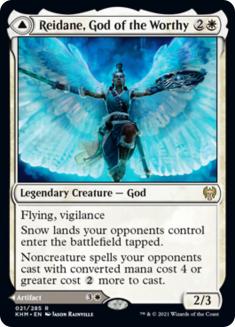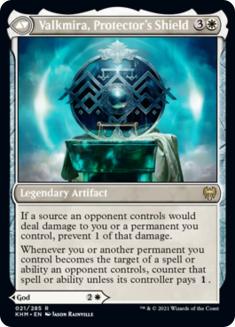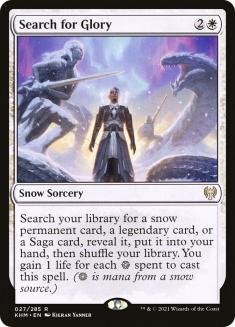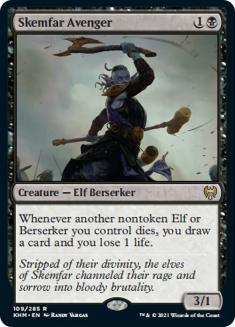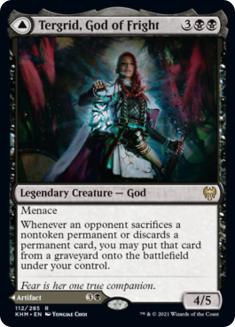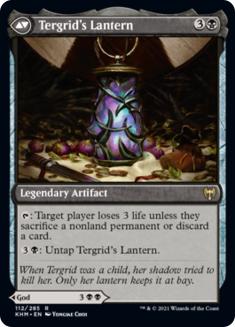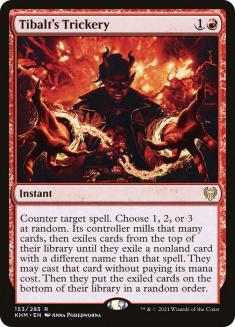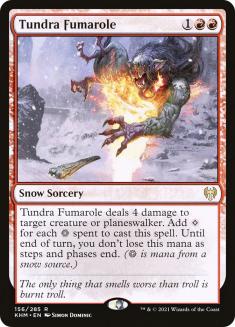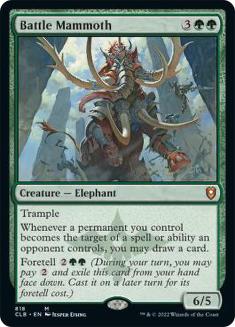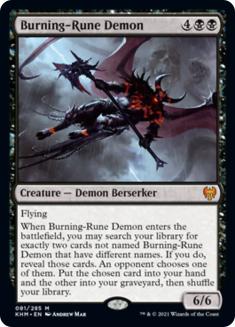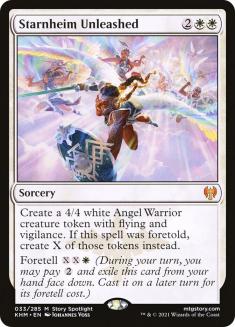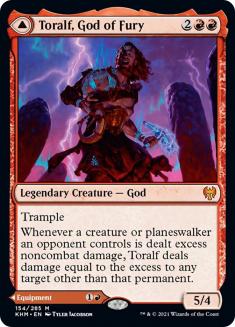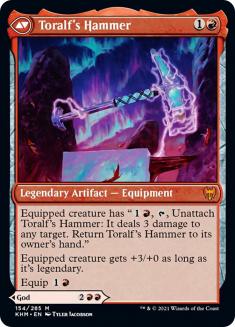Welcome back to the second part of my financial review of Kaldheim! I’m really excited about this set, as the card level is generally very high (but not in a broken sense) and the uncommons and rares are more pushed than usual. I’d like to get straight into my review, so I’ll end the preamble with two points:
- You can read Part 1 of my financial review of Kaldheim below:
- I stated it last week but I’ll restate it here: the preorder pricing philosophy of Star City Games is to try to get the cards as close to a stable price as possible. In previous years, you might see the price of cards drop precipitously post-release. That hasn’t been the case for our preorder prices for a few set releases. The prices I talk about here are the prices we believe will be sustainable post-release.
Common
You’re not going to find many commons breaking the $0.15-$0.25 bulk price these days due to widespread availability. There were a few interesting commons previewed since my last article that may have a slight premium foil value. I say “slight” because the proliferation of foils from Collector Booster packs of Kaldheim will continue to drive the value of foil commons and uncommons downwards.
Uncommon
The bulk price for an uncommon is $0.25. Here are the uncommons previewed since last week that we’ve priced above bulk:
Fynn, the Fangbearer: $0.50
Mark Rosewater promised that Kaldheim would contain a way to poison an opponent to death. Poison is an extremely polarizing mechanic but the people who love poison really love poison. Two for a 1/3 deathtouch creature is fine and this could be a plant for the poison mechanic coming back in earnest in an upcoming set.
Saw It Coming: $0.50
Countermagic is in a weird place where Counterspell is a little too good to insert into Standard but Cancel hasn’t quite been good enough. It’s difficult to find the additional ability that makes Cancel up-to-snuff. There have been plenty of other hard counters at 1UU. Typically these have split into three camps:
- 1UU and there’s a tacked-on effect for the cost. Examples include Didn’t Say Please, Dissipate, Dissolve, Neutralize, and Sinister Sabotage.
- 1UU and there are modal aspects to the spell. Examples include Disallow and Scatter to the Winds.
- 1UU and there’s an alternate cost aspect to the spell. Examples include Admiral’s Order, Disappearing Act, Stoic Rebuttal, and Wizard’s Retort.
Saw It Coming falls firmly into that third camp. The foretell cost makes this either a two-mana counterspell or a four-mana counterspell, depending on how you look at the opportunity cost. I personally think it falls more in the two-mana counterspell mode. There are going to be a lot more games where the caster feels thankful to have a two-mana counterspell in exile than feeling that they spent too much mana investing in the spell.
Weathered Runestone: $0.75
Playable hate artifacts at uncommon and costing two to three mana tend to end up in the $0.50 to $2 range. The high end of this range in recent memory is Damping Sphere. Weathered Runestone is fine against many strategies that are centric to Eternal formats. Dredge, Reanimator, and their ilk get shut down on the first turn via Mishra’s Workshop, Ancient Tomb, or City of Traitors. This doesn’t stop lands (so the aptly named Lands deck still gets to go with its gameplan).
More importantly, Commander is the driver for card prices this day. This is fine as a card in your 100, especially if you have people who like doing a lot of recursion from their graveyards. Weathered Runestone is playable in Commander so it will maintain value and desirability.
Rare ($2 or higher)
Ascendant Spirit: $2.50
I believe Ascendant Spirit is currently being undervalued. Previous versions of this card, such as Figure of Destiny and Warden of the First Tree, were eminently playable in their formats. Ascendant Spirit curves better than either of those two cards. It also can be activated multiple times on the last ability.
For instance, you have activated the first and second abilities, and have a 4/4 flying Spirit Warrior Angel with flying on Turn 3. On Turn 4, you activate the third ability and Ascendant Spirit gets two +1/+1 counters and gains “Whenever this creature deals combat damage to a player, draw a card.” You can then keep activating this ability in future turns, growing Ascendant Spirit and adding additional “draw a card” triggers. Each “draw a card” triggers separately! So if Ascendant Spirit is pumped to a 10/10 with three instances of “draw a card,” it’s going to draw three cards each time it hits an opponent.
Furthermore, the activation of Ascendant Spirit is via snow mana. This means any deck can run Ascendant Spirit as long as you can put the down payment of a single blue mana to get it out to begin with.
I think that based on versatility, ease of ability to splash, and attractiveness in multiple formats, Ascendant Spirit will go up in value once people get to play with it.
Cosima, God of the Voyage // The Omenkeel: $4
I don’t like to overhype new cards, but Cosima, God of the Voyage // The Omenkeel is another card being undervalued right now. Both sides of this card are excellent, with Cosima being a self-contained win condition that plays into virtually every blue control plan ever printed and The Omenkeel letting blue get down an early defense while also allowing for the possibility for ramping.
Cosima fits into the exact same ramp engine that previously had Omnath, Locus of Creation. Omnath was a better card but Omnath was also strong enough to get banned in Standard! I think the following play is realistic:
- Turn 3: Cast Cosima.
- Turn 4: Exile Cosima on your upkeep, play Fabled Passage (one voyage counter), sacrifice Fabled Passage and put a basic land onto the battlefield untapped (a second voyage counter), cast Cultivate or Fertile Footsteps (a third voyage counter).
- Turn 5: Bring Cosima back as a 5/7 creature and draw three cards.
Then there’s the Lotus Cobra line:
- Turn 2: Cast Lotus Cobra.
- Turn 3: Cast Cosima.
- Turn 4: Play Fabled Passage (one voyage counter and one additional mana from Lotus Cobra); sacrifice Fabled Passage and put a basic land onto the battlefield untapped (a second voyage counter and a second additional mana from Lotus Cobra); use three of your six mana to cast Cultivate (a third voyage counter and an additional mana from Lotus Cobra, leaving you with four mana left for the turn); cast Azusa, Lost but Seeking or Dryad of the Ilysian Grove and play another land (a fourth voyage counter and an additional mana from Lotus Cobra); and then cast a second Cosima.
- Turn 5: At the beginning of your upkeep, send the second Cosima (currently on the battlefield) into exile, return the first Cosima from exile as a 6/8 (thanks to the four voyage counters from last turn), draw four cards, and have the second Cosima sitting in exile getting voyage counters like the first one did last turn.
While the second scenario may be rarer, we must remember how frequently Omnath decks executed the plan. In this case, you’re looking at a two-color deck instead of four-color one.
I know that Standard isn’t the driver for card prices at the moment so let me mention that Cosima is also attractive in Commander. Therefore, the dual threat of these two should make it a more valuable card than its current price. If I could recommend two cards in Kaldheim that I feel are underpriced and are worth picking up now, they’d be Cosima, and Ascendant Spirit.
Egon, God of Death // Throne of Death: $4
The worst-case scenario on Egon, God of Death is playing it Turn 3, having a 6/6 deathtouch blocker for a turn, and then drawing a card when it dies. The best-case scenario is essentially a reverse Rotting Regisaur, though the Dinosaur was a lot more reliable since it wouldn’t die if you couldn’t satisfy its upkeep trigger.
The flip side of Egon is Throne of Death, a one-drop that mills each turn. This is an extremely reliable and early way to set up the draws for any deck that cares about filling its graveyard early. In addition, it’s a good late-game draw because your excess mana turns into extra draws.
Lastly, drawing these in multiples is fine, since the artifact side feeds the creature side!
With that all said, I think $4 is a little high. This is more of a situational player than some of the other Gods we’ve seen, and it isn’t as splashy for Commander. I expect Egon to go down to the $2-$3 range, unless there’s some must-play graveyard deck that Throne of Death slots into.
Faceless Haven: $2
The snow deck in Standard is the real deal. There are enough snow lands and effects to push a dedicated snow deck into playable territory. In addition, snow is a popular mechanic for Commander players.
Faceless Haven, despite being both a snow land and a win condition, is probably not good enough to see play. Frostwalk Bastion is the closest comp I have here and Frostwalk Bastion wasn’t really that exciting of a card.
Even though Faceless Haven will see some Standard play in snow-centric decks, I don’t think it will be enough to keep this card from slipping to the $1 range quickly after release.
In Search of Greatness: $4
Let’s parse In Search of Greatness together because I’ve seen many people misread it. This enchantment lets you do one of two things during your upkeep:
- Scry 1.
- Cast a permanent spell from your hand for free, where that spell has a converted mana cost of one plus the highest converted mana cost among other permanents you control.
Things to note:
- In Search of Greatness says “other permanents.” That means that In Search of Greatness does not count itself. If it’s your only nonland permanent, you get to cast a free one-mana permanent since your lands are other permanents and have converted mana cost of zero.
- The mana cost of the spell must be exactly one plus the highest converted mana cost among other permanents you control. If you control a one-drop, a three-drop and a five-drop, the only spells you can cast for free cost six, since the five-drop is your most expensive permanent.
I think the effect of getting things for free is worse than most people think. I can’t count the number of people who thought that In Search of Greatness counted itself, so you’d get a free three-drop on Turn 3. But you don’t! You get a free one-drop as mentioned above.
On the other hand, scry 1 for GG is a perfectly fine effect on its own. This is worse than Search for Azcanta — putting cards in your graveyard is better and Search for Azcanta transforms into a very good card — but the ability to filter your draws every turn for the entire game is pretty powerful.
This should be a fairly popular casual card, so the value of In Search of Greatness should stay pretty constant. I just don’t see it spiking due to Eternal play, despite comparisons to cards like Aether Vial.
Jorn, God of Winter // Kaldring, the Rimestaff: $4
The front half of Jorn, God of Winter is an earlier (but more fragile) Wilderness Reclamation. I think it’s realistic to attack with Jorn on Turn 4, allowing you to have one of two scenarios:
- You get to cast your spells precombat and then have everything untapped for countermagic afterwards.
- You have eight mana floating during combat on your fourth turn for something like cycling Shark Typhoon or powering up Ascendant Spirit multiple times.
Either way, Jorn slots into a revamped Temur Reclamation deck that takes advantage of snow permanents and spells.
As for Kaldring, the Rimestaff, it is decidedly a Dimir card and might shift the proposed deck above from Temur Reclamation to Sultai Reclamation. This legendary snow artifact looks to be pretty insane; it’s not Lurrus of the Dream-Den good but it’s the Lurrus of a dedicated snow deck. It doubles as a Crucible of Worlds for snow lands, offers repeatable one-mana card draw with Arcum’s Astrolabe in formats where Arcum’s Astrolabe is legal, and is a way to recur your win conditions.
Mystic Reflection: $4
Mystic Reflection is sought-after almost exclusively for Commander play. There are some pretty ridiculous plays you can make with Mystic Reflection, including:
- Cast Myr Battlesphere. With the trigger to put four 1/1 colorless Myr artifact creature tokens on the battlefield, cast Mystic Reflection on Myr Battlesphere. Each token instead enters as a Myr Battlesphere.
End result: Five copies of Myr Battlesphere and sixteen 1/1 colorless Myr artifact creature tokens. - Cast Avenger of Zendikar. Let’s assume nine lands are on the battlefield. In response to the “Create a 0/1 green Plant creature token for each land you control” trigger, cast Mystic Reflection on Avenger of Zendikar. All nine Plant tokens enter as Avenger of Zendikar and each one creates nine more 0/1 Plant tokens.
End result: Ten copies of Avenger of Zendikar and 81 0/1 green Plant creature tokens. - Cast Master of Waves. Assume your devotion to blue is four. With the “create a number of 1/0 blue Elemental creature tokens equal to your devotion to blue” trigger on the stack, cast Mystic Reflection targeting Master of Waves. All four tokens enter as Master of Waves. Each of those creates eight more 1/0 blue Elemental tokens (since your devotion to blue is now eight instead of four).
End result: Five copies of Master of Waves, 32 6/5 blue Elemental tokens (thanks to being pumped +5/+5 by five copies of Master of Waves). - Cast Monkey Cage and then any non-legendary creature (let’s use Craterhoof Behemoth in this example). Once Craterhoof Behemoth enters the battlefield, cast Mystic Reflection targeting Craterhoof Behemoth with the Monkey Cage trigger on the stack.
End result: Nine copies of Craterhoof Behemoth, all of which are 14/14 until end of turn. Enjoy your 126 power of hasty green creatures!
Suffice it to say, there are a number of degenerate things you can do with Mystic Reflection in Commander. Much like Rite of Replication, Mystic Reflection should be a pretty popular card and maintain value.
Reidane, God of the Worthy // Valkmira, Protector’s Shield: $3
I don’t think that either side of this card is particularly great. Reidane, God of the Worthy is too small and has two very narrow category types of card it hoses. Valkmira, Protector’s Shield is an improved Urza’s Armor — when’s the last time you heard about that card? — except it doesn’t prevent damage dealt to you by yourself (no Pestilence / Pyrohemia hijinks). The spend one extra mana to target clause is nice, but again I just don’t think this card does enough to be all that interesting. I expect it to drop to the $1 range quickly after release.
Search for Glory: $2
Search for Glory has three things going for it:
- There hasn’t been an outright tutor for snow permanents before, so this is a shoo-in for any snow-centric deck in Commander.
- Search for Glory itself is a snow sorcery, which is going to matter for decks in Standard.
- Being able to just randomly search up a legendary card is pretty great. This slots in nicely between Time of Need and Captain Sisay in a legend-centric Commander deck. It also is a white alternative to Time of Need.
Skemfar Avenger: $3
Both Elves and Berserkers are getting pushed in this set. I’m sure there’s going to be a viable Elf tribal deck in Standard (less sure on Berserkers), and Skemfar Avenger will be key in that deck. It’s also an auto-include for any Golgari Elf Commander deck. If either Elves or Berserkers get pushed further over the next months (looking at you, Forgotten Realms!), this could go even higher.
Tergrid, God of Fright // Tergrid’s Lantern: $5
The front side of Tergrid, God of Fright is an absolute powerhouse in Commander. Being able to reanimate creatures for free is completely nuts and there are plenty of ways to force a sacrifice in that format (much less people just sacrificing as part of their natural gameplan). In addition, the discard ability turns things like Bottomless Pit into truly frightening monstrosities that must be dealt with immediately.
And let’s not even think about the game where someone is going to get Tergrid, God of Fright and follow it with a Myojin of Night’s Reach activation, putting untold huge creatures onto the battlefield on their side at once.
But wait, there’s more!
Tergrid’s Lantern is a repeatable, permanent Torment of Hailfire, a $12 Commander staple. While Torment of Hailfire is more efficient — it hits all opponents, and it scales better — the repeatable nature of Tergrid’s Lantern is going to make it a very attractive option.
Tibalt’s Trickery: $5
Red gets a hard counter that also doubles as a way to cheat Emrakul, the Aeons Torn onto the battlefield. With Sensei’s Divining Top, there is a 66% chance you get the third card down in response to Tibalt’s Trickery. With a dedicated Goblin Charbelcher deck, you can guarantee the fourth card down and use Tibalt’s Trickery to cheat anything you want onto the battlefield.
Tibalt’s Trickery is going to see a ton of play in Commander for the same reason that Chaos Warp does — it deals with things in a way red normally can’t deal with cards (in this case spells). It can also be used offensively in a pinch. I don’t know if it will maintain at $5 unless there’s a dedicated combo deck in competitive Magic that sticks, but I do think it’ll stay above bulk value (probably more in the $3 range) and then slowly climb back up to $5 as supply dries up.
Tundra Fumarole: $2.50
The value of Tundra Fumarole will correspond directly to how competitive snow decks end up in Standard, Historic, and Pioneer. If snow is finally pushed far enough to be viable, Tundra Fumarole is an auto-include in any deck that plays red (I personally think it’s there in at least Standard).
Mythic
Battle Mammoth: $5
This is basically going to fill the role of a mono-green Leovold, Emissary of Trest in Commander without the hate of pinning people down to one draw a turn. I think in that regard, Battle Mammoth will be a success.
I don’t think Battle Mammoth will make the cut in Standard. Even cheating it out early with foretell as a four-drop, there isn’t a deck I can think of that cares this much about protecting permanents. Yorion decks are either going to counter the Mammoth or kill it immediately. Gruul Adventures will potentially play this, but Questing Beast is already only a two-of in that deck, so does it even slot?
I think Battle Mammoth will initially drop in price, to around the $3-$4 range.
Burning-Rune Demon: $4
I really dislike this card. It’s half a Gifts Ungiven in a color that has so many tutoring options that I can’t think of many instances of where you’d want an almost-tutor at six mana. Yes, there are going to be some times when either choice is bad for your opponent in your hand or graveyard, but in most cases I think players would rather just pay one more mana, get Rune-Scarred Demon, and guarantee which card is going to their hand.
I think due to better options being available for this sort of effect (either a stronger effect or this effect at a more mana-efficient cost), Burning-Rune Demon is going to end up near bulk mythic rare price. I anticipate $1-$2 on this card and I don’t see it moving up from there.
Starnheim Unleashed: $7
On the other hand, Starnheim Unleashed is pretty nuts. We’ve power crept to the point where Serra Angel is now a four-mana card in Standard. A four-mana Serra Angel by itself probably isn’t anything to be excited about. The foretell ability on Starnheim Unleashed is where this mythic shines.
The comps I have with this card are Decree of Justice, Emeria’s Call, Entreat the Angels, and Finale of Glory. These are all cards that can mass-drop 4/4 vigilance Angel creature tokens.
In Standard, the only direct comparison I have is with Emeria’s Call and having the flip side of Emeria’s Call as a land is extremely strong. However, Emeria’s Call also costs triple-white mana to cast, making it highly color-intensive. Starnheim Unleashed is eminently splashable as a foretell card and it gives a much better rate of making Angels as well.
- Emeria’s Call: seven mana for two Angels.
- Starnheim Unleashed (after foretell): five mana for two Angels or seven mana for three Angels.
I think that in general, Starnheim Unleashed hits the mark of getting you enough of a flexible threat to see Standard play. It’s key that the foretell cost only takes a single white, putting this in the same category of splashable as Shark Typhoon (though Shark Typhoon is better since it can be cycled at instant speed).
We can compare Starnheim Unleashed to Decree of Justice, Entreat the Angels, and Finale of Glory for Commander play. Let’s start with Decree of Justice:
- Decree of Justice: five mana for two 1/1 Soldiers and draw a card or seven mana for four 1/1 Soldiers and draw a card.
- Starnheim Unleashed (after foretell): five mana for two 4/4 Angels or seven mana for three 4/4 Angels.
The front-side comparison isn’t even fair, as Decree of Justice costs an extra 2W just to create the first Angel token, so it will always be behind Starnheim Unleashed in creating Angel tokens.
WINNER: Starnheim Unleashed
Next up is Finale of Glory:
- Finale of Glory: five mana for three 2/2 Soldiers, seven mana for five 2/2 Soldiers, or nine mana for seven 2/2 Soldiers.
- Starnheim Unleashed (after Foretell): five mana for two 4/4 Angels, seven mana for three 4/4 Angels or nine mana for four 4/4 Angels.
Unless you specifically care about quantity over quality, Starnheim Unleashed is a better card prior to ten mana. At ten mana, the formula changes. Once you get to this magic number, Finale of Glory is going to be better than Starnheim Unleashed since Finale gives you eight Angels in addition to the Soldiers.
I think that Starnheim Unleashed is probably slightly better than Finale of Glory because of the additional flexibility early on. Remember — with foretell, you’re casting your both Finale of Glory and Starnheim Unleashed as early as Turn 3. I think that Finale of Glory is better if your metagame tends towards slower decks and tons of ramp.
WINNER: Starnheim Unleashed (but barely)
Finally, let’s compare to Entreat the Angels.
Starnheim Unleashed is better when cast fair while Entreat the Angels is better when cheated (foretell versus miracle), but miracle is a lot harder to control than foretell. In addition, if you get Entreat the Angels in your opening hand, it’s not going to be better than Starnheim Unleashed at any metric.
WINNER: Starnheim Unleashed (though Entreat the Angels is still the champion of Legacy).
In short, this is probably the most versatile create-Angels card ever printed for Commander. Between that and power level in Standard, I think Starnheim Unleashed will keep its current value and maybe even go up a dollar or two.
Toralf, God of Fury // Toralf’s Hammer: $7
There are two playable cards that have similar abilities in this set. Aegar, the Freezing Flame draws cards when excess damage is dealt and Toralf, God of Fury redirects noncombat damage when excess damage is dealt. Aegar is an uncommon and I think has a ton of potential to go up once supply dries up, while Toralf is a mythic, has a much larger body, and plays very well into red’s gameplan of just unleashing a relentless onslaught of damage.
In Standard, you’re looking to combine this with cards like Cinderclasm, Crush the Weak, or Purphoros’s Intervention.
Example: You have Toralf, God of Fury on the battlefield. On Turn 5, you drop a land and cast Purphoros’s Intervention on your opponent’s Questing Beast. You’re killing the Beast and doing an additional four damage directed to whatever other target you want. Kill another creature? Dome your opponent for damage? Both good choices!
This gets even more exciting with Shatterskull Smashing, a card that’s already being played in Standard. Instead of hitting just two targets, you’re hitting potentially four targets, including your opponent since the redirect can go straight at their head.
In Commander, you’ll do extremely silly things with Toralf, God of Fury and Blasphemous Act.
Example: Your opponents control seven creatures. On Turn 5, you play Toralf, God of Fury followed immediately by Blasphemous Act.
Assume the average toughness of your opponents’ creatures is four. Blasphemous Act deals thirteen damage to seven creatures (91 total damage). 28 of that damage is eaten by toughness, and the other 63 damage gets redirected straight at your opponents.
Congratulations! You’ve instantly wiped the battlefield and taken out at least one opponent outright!
As for Toralf’s Hammer, it’s a Lightning Bolt that costs six mana and tapping a creature to use repeatedly. The initial cast is two mana, the initial equip is two mana, but the Equipment doesn’t actually do anything for non-legendary creatures (the +3/+0 is only for legendary creatures).
Generally I think the Equipment side is extremely weak, so the power of this card is on the front side.
What’s Next
Next week, we’ll have the titanic conclusion to this series, in which I’ll cover the last few mythic rares and regular rares! Marvel at the sight of the full Kaldheim Commander decklists! Revel in the reveal of which cards have gone up (or down) in value since the Kaldheim Financial Set Review started! This is an amazing, stupendous conclusion to this series that you cannot miss under any circumstance!
And I’m not just saying that because Cedric said my closing paragraphs need extra work!

